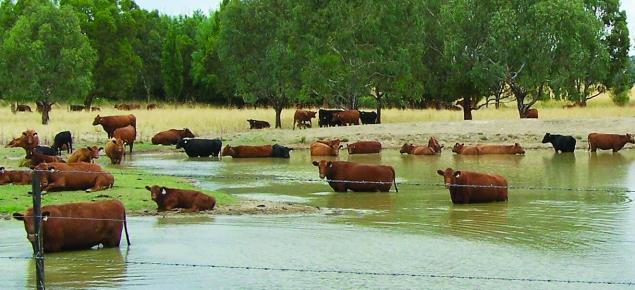Toxic algal blooms
When a body of water becomes discoloured with a super abundance of free-floating, microscopic plant or, in rare cases, animal life, it is said to develop a ‘water bloom’ or algal bloom. Algae are primitive plants and include seaweeds, fine hair-like green forms and microscopic single cells or colonies. Some of the microscopic species are the most dangerous and can multiply rapidly to produce prominent green, red, yellow and other discolouration of water. A group of algae known as blue-green algae produces the most spectacular blooms in fresh water dams and several of these can produce toxins when conditions are favourable.
Livestock losses on stations in the Victoria River district of the Northern Territory have previously been associated with algal blooms.
Poisoning of livestock
Blue-green algae (cyanobacteria) blooms thrive in warm, calm, shallow bodies of water where the water is hard, alkaline, and rich in nitrogen, phosphates, carbonates, and organic matter. These algal blooms can pose a threat to livestock as poisoning can occur if they swallow the algae while drinking the contaminated water. Fish are often safe until a pond or dam dries or is drained, bringing them into contact with floating algae.
Poisonings attributed to blue-green algae usually occur in the dry season. Runoff from arable land and animal droppings greatly increase the likelihood of algal blooms ponds or lakes.
Blooms of the blue-green alga Nodularia spumigena form a scum on sheltered shorelines when concentrated by winds or currents and can form a suspension in the water. The blue-green algae species most commonly associated with the deaths of livestock, waterfowl and fish are Microcystis aeruginosa and Anabaena circinalis. Anabaena and Nodularia have been implicated in skin and eye irritations in people and dogs, while Microcystis, Anacystis, and another less commonly encountered alga, Lyngbya, have been reported to cause hay fever symptoms.
Symptoms of poisoning
The most common sign is finding a dead animal near affected water. In some cases, the forelimbs, lips and muzzle of the animal will show traces of algal scum.
Post-mortem examination will sometimes reveal bleeding from the tiny blood vessels under the skin and between the muscles. However, it can be difficult to make a confident diagnosis of algal poisoning, since the clinical signs and post-mortem findings can resemble a variety of diseases.
If stock must be moved to another paddock, do it at a very easy pace.
Identification of algae
Once livestock have been moved, seek veterinary advice to confirm the diagnosis and send a sample of the bloom for identification to the Berrimah Veterinary Laboratories where it will be viewed under high magnification to identify the algae.
Algae submitted for identification should preferably be fresh and healthy and the water sample is to be submitted in a small (100 millilitre) screw-topped jar fresh, or, if possible, with sufficient formalin added to make up a three per cent solution.
Treatment and prevention of contamination of farm water supplies by algal blooms
Station water supplies
Algae in water tanks may be controlled by covering the tank to exclude light and reduce the temperature.
Deep dams are better than shallow dams as they reduce algal use of the sun’s energy. The nutrient levels in station dams may be reduced by screening systems. These screening systems reduce fouling of dam water by stock excreta and plant debris, and ensure the restriction of fertilisers in the immediate catchment area. The screens also ensure that the size of the catchment area is large enough to cater for sufficient runoff to cause an overflow in most seasons.
Chemical control
Dosing dams with alum and gypsum has proven to be an effective means of removing phosphorus from the water. As the phosphorus is the most important nutrient for blue-green algae, the removal of this can prevent the algae from forming. For the best results, dams should be dosed prior to the formation of the bloom. If the dam is dosed after the bloom has started to form, stock should be excluded from the water source for five days as algae are at their most toxic as they are dying off.
It is recommended that the alum and gypsum should be applied at a rate of 50 kilograms of alum and 50 kilograms of gypsum per megalitre of water. The alum crystals are to be added first and should be mixed in to the water. The water should be left to stand for a few hours prior to adding gypsum. Once the gypsum has been added, let the water stand for at least 24 hours, or until clear. If the water has not cleared in two to three days, add an additional 25-30 per cent of the recommended dosage of the alum and gypsum.
A preliminary trial can be conducted by filling a 44-gallon drum with the dam water to ensure that the dosage is correct. Once the dam has been dosed and becomes clear, a pool pH test kit can be used to ensure that the pH is between six and nine. If the pH is not in the right range, allow the water to stand two days and check again.
Please note that older algal treatments are not environmentally friendly and should not be used.
Reference:
New South Wales Department of Primary Industries 2013, viewed 21 December 2016.
Figure 5: Cattle in dam containing algal bloom
Give feedback about this page.
Share this page:
URL copied!
